Range table for US 3-inch (76.2 mm) field gun, models 1902-1905
This gun used a standard "fixed" cartridge with 15 lb (6.8 kg) shell, hence a single set of tables applied to all its ammunition.

A range table was a list of angles of elevation a particular artillery gun barrel needed to be set to, to strike a target at a particular distance with a projectile of a particular weight using a propellant cartridge of a particular weight. They were used for several centuries by field and naval gunners of all countries until gradually replaced by computerised fire-control systems beginning in World War II (1939–1945).
This gun used a standard "fixed" cartridge with 15 lb (6.8 kg) shell, hence a single set of tables applied to all its ammunition.

Different propellant charges were used to achieve required range, angle of descent and flight time. This is typical of mortars and howitzers.
(Provisional) Range Table For 3-Inch Stokes Mortar, Printed in September 1917. [1]
Cartridge : 95 gr (6.2 g) ballistite, reinforced with Charges : 5 grains, guncotton yarn
Rings : 110 gr (7.1 g), .3 mm flake cordite
Projectile : Bomb, 10 lb. 11 oz (4.85 kg)
| Cartridge Only | 1 Ring | 2 Rings | 3 Rings | 4 Rings | ||||||
|---|---|---|---|---|---|---|---|---|---|---|
| Range | Time of Flight | Range | Time of Flight | Range | Time of Flight | Range | Time of Flight | Range | Time of Flight | |
| degs | yds | secs | yds | secs | yds | secs | yds | secs | yds | secs |
| 45 | 240 | 7·1 | 420 | 9·6 | 550 | 11·6 | 660 | 13·2 | 800 | 15·0 |
| 50 | 233 | 7·6 | 411 | 10·4 | 538 | 12·5 | 649 | 14·3 | 780 | 16·2 |
| 52 | 228 | 7·8 | 404 | 10·7 | 530 | 12·9 | 639 | 14·7 | 767 | 16·6 |
| 54 | 222 | 8·0 | 395 | 10·9 | 518 | 13·2 | 626 | 15·1 | 748 | 17·0 |
| 56 | 215 | 8·2 | 384 | 11·2 | 503 | 13·5 | 608 | 15·4 | 726 | 17·4 |
| 58 | 207 | 8·4 | 371 | 11·4 | 486 | 13·8 | 589 | 15·8 | 701 | 17·8 |
| 60 | 197 | 8·5 | 357 | 11·7 | 467 | 14·1 | 567 | 16·1 | 672 | 18·2 |
| 61 | 193 | 8·6 | 349 | 11·8 | 457 | 14·3 | 554 | 16·3 | 656 | 18·4 |
| 62 | 187 | 8·7 | 340 | 11·9 | 445 | 14·4 | 542 | 16·4 | 640 | 18·5 |
| 63 | 182 | 8·8 | 332 | 12·0 | 434 | 14·5 | 528 | 16·6 | 623 | 18·7 |
| 64 | 176 | 8·8 | 323 | 12·1 | 422 | 14·6 | 514 | 16·7 | 605 | 18·8 |
| 65 | 170 | 8·9 | 313 | 12·2 | 409 | 14·8 | 499 | 16·9 | 586 | 19·0 |
| 66 | 164 | 9·0 | 303 | 12·3 | 396 | 14·9 | 483 | 17·0 | 567 | 19·1 |
| 67 | 158 | 9·0 | 292 | 12·4 | 383 | 15·0 | 468 | 17·1 | 547 | 19·2 |
| 68 | 152 | 9·1 | 281 | 12·5 | 369 | 15·1 | 451 | 17·2 | 526 | 19·4 |
| 69 | 145 | 9·2 | 270 | 12·5 | 354 | 15·2 | 434 | 17·4 | 505 | 19·5 |
| 70 | 138 | 9·2 | 259 | 12·6 | 339 | 15·3 | 416 | 17·5 | 483 | 19·6 |
| 71 | 131 | 9·2 | 247 | 12·7 | 324 | 15·4 | 398 | 17·6 | 460 | 19·7 |
| 72 | 124 | 9·3 | 235 | 12·8 | 308 | 15·5 | 379 | 17·7 | 437 | 19·8 |
| 73 | 117 | 9·3 | 223 | 12·9 | 292 | 15·5 | 360 | 17·8 | 413 | 19·9 |
| 74 | 109 | 9·4 | 210 | 12·9 | 275 | 15·6 | 340 | 17·9 | 389 | 20·0 |
| 75 | 102 | 9·4 | 197 | 13·0 | 259 | 15·7 | 320 | 18·0 | 364 | 20·1 |
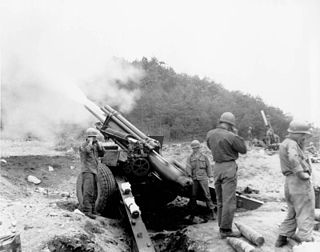
A howitzer is generally a large ranged weapon that stands between an artillery gun – which has smaller, higher-velocity shells fired at flatter trajectories – and a mortar – which fires at higher angles of ascent and descent. Howitzers, like other artillery equipment, are usually organized in a group called a battery.

The 8.8 cm KwK 43 was an 88 mm 71 calibre length tank gun designed by Krupp and used by the German Wehrmacht during the Second World War. It was mounted as the primary armament on the Panzerkampfwagen VI Ausf. B Tiger II. The 8.8 cm Pak 43, an anti-tank gun, was very similar in design but mounted on tank destroyers or deployed stand-alone on the field.

A mortar is usually a simple, lightweight, man-portable, muzzle-loaded weapon, consisting of a smooth-bore metal tube fixed to a base plate with a lightweight bipod mount and a sight. They launch explosive shells in high-arcing ballistic trajectories. Mortars are typically used as indirect fire weapons for close fire support with a variety of ammunition.
This article explains terms used for the British Armed Forces' ordnance and also ammunition. The terms may have slightly different meanings in the military of other countries.

The M2 Mortar is a 60 millimeter smoothbore, muzzle-loading, high-angle-of-fire weapon used by U.S. forces in World War II, the Korean War, and the Vietnam War for light infantry support.

The Stokes mortar was a British trench mortar designed by Sir Wilfred Stokes KBE that was issued to the British and U.S. armies, as well as the Portuguese Expeditionary Corps, during the latter half of the First World War. The 3-inch trench mortar is a smooth-bore, muzzle-loading weapon for high angles of fire. Although it is called a 3-inch mortar, its bore is actually 3.2 inches or 81 mm.

The Newton 6-inch mortar was the standard British medium mortar in World War I from early 1917 onwards.
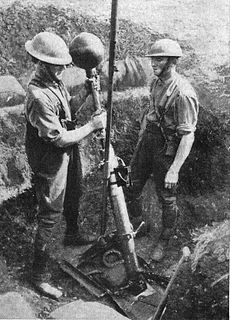
The 2 inch medium trench mortar, also known as the 2-inch howitzer, and nicknamed the "toffee apple" or "plum pudding" mortar, was a British smooth bore muzzle loading (SBML) medium trench mortar in use in World War I from mid-1915 to mid-1917. The designation "2-inch" refers to the mortar barrel, into which only the 22-inch bomb shaft but not the bomb itself was inserted; the spherical bomb itself was actually 9 inches (230 mm) in diameter and weighed 42 lb (19 kg), hence this weapon is more comparable to a standard mortar of approximately 5-6 inch bore.

The PAW 600 was a lightweight anti-tank gun that used the high-low pressure system to fire hollow charge warheads. In 1945, it was used operationally by the Wehrmacht in small numbers. Only about 250 were produced before the war's end.

The 240 mm Trench Mortar, or Mortier de 240 mm, was a large calibre mortar of World War I. An original French design, it was developed by Batignolles Company of Paris and introduced in 1915.

The Ordnance BL 5-inch howitzer was initially introduced to provide the Royal Field Artillery with continuing explosive shell capability following the decision to concentrate on shrapnel for field guns in the 1890s.
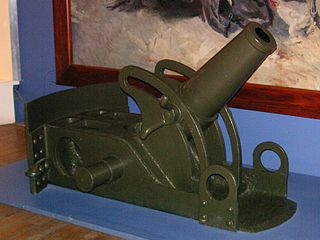
The Mortier de 58 mm type 2 or Mortier de 58 mm T N°2, also known as the Crapouillot or "little toad" from its appearance, was the standard French medium trench mortar of World War I.
The BL 6-inch gun Marks II, III, IV and VI were the second and subsequent generations of British 6-inch rifled breechloading naval guns, designed by the Royal Gun Factory in the 1880s following the first 6-inch breechloader, the relatively unsuccessful BL 6-inch 80-pounder gun designed by Elswick Ordnance. They were originally designed to use the old gunpowder propellants but from the mid-1890s onwards were adapted to use the new cordite propellant. They were superseded on new warships by the QF 6-inch gun from 1891.

The 68-pounder cannon was an artillery piece designed and used by the British Armed Forces in the mid-19th century. The cannon was a smoothbore muzzle-loading gun manufactured in several weights, the most common being 95 long cwt (4,800 kg), and fired projectiles of 68 lb (31 kg). Colonel William Dundas designed the 112 cwt version in 1841 and it was cast the following year. The most common variant, weighing 95 cwt, dates from 1846. It entered service with the Royal Artillery and the Royal Navy and saw active service with both arms during the Crimean War. Over 2,000 were made and it gained a reputation as the finest smoothbore cannon ever made.
The ML 8 inch shell guns of 50 cwt, 54 cwt and 65 cwt were the three variants of British cast iron smoothbore muzzle-loading guns designed specifically to fire the new generation of exploding shells pioneered in the early-mid nineteenth century by Henri-Joseph Paixhans.

The Albrecht Mortar or Albrecht Schwerer Minenwerfer was a series of wooden heavy mortars used by the Imperial German Army during the First World War.

The Mortier de 75 modèle 1915 Schneider was a French trench mortar designed and built by Schneider that saw action with the French and Belgian Army during the First World War.
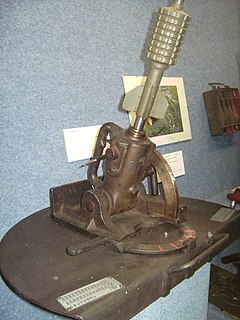
The kleineGranatenwerfer 16 or Gr.W.16(Small Grenade Launcher Model 1916) in English, was an infantry mortar used by the Central Powers during the First World War. It was designed by a Hungarian priest named Father Vécer and was first used by the Austro-Hungarian Army in 1915. In Austro-Hungarian service, they received the nickname "Priesterwerfers". In 1916 Germany began producing a modified version under license for the Imperial German Army.

The Mortier de 58 T N°1 sometimes referred to as Lance Torpilles was an early French medium trench mortar of World War I. Built in small numbers it was a transitional type in the development of later French mortars.
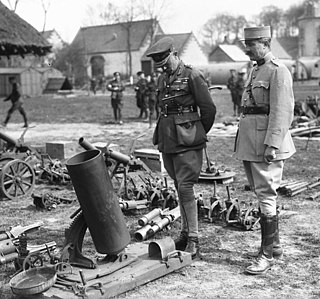
The 24 cm schwerer LadungsWerfer Ehrhardt shortened to 24 cm sLW Ehrhardt, or (24 cm Heavy Charge Thrower Ehrhardt) in English was a heavy mortar used by the Imperial German Army during the First World War.